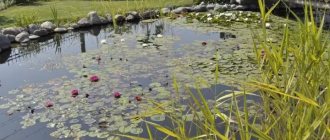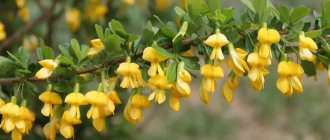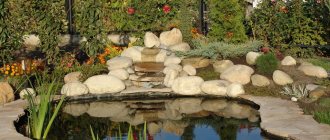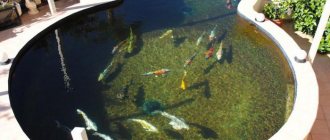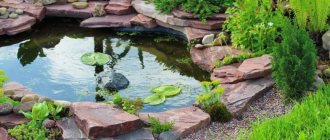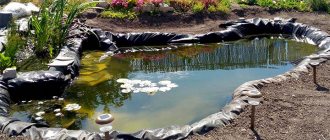The work of preparing a decorative pond for winter often frightens beginners. But this procedure is not that complicated. The main thing is to take into account the type of reservoir and properly take care of its inhabitants, in particular plants and fish.
Start preparing your pond for winter before the cold weather sets in. Before leaf fall begins, cover it with a net to prevent leaves from falling into the water. If this is not done, the leaves will soon sink to the bottom and begin to rot. As a result, they will not only spoil the beauty, but also pollute the reservoir. If leaves do end up in the pond, catch them with a net or a special water vacuum cleaner.
Preparing a fish pond for winter
In mid-latitudes, winters are most often cold and frosty. Reservoirs freeze, and often to great depths. DIY decorative ponds suffer significantly in such conditions. The walls and bottom are deformed, flora and fauna die. Standing water becomes stale.
There are preparatory measures for wintering artificial ponds:
- cleaning water from debris;
- pumping out water;
- dismantling and checking equipment;
- cleaning the bottom and walls;
- transfer of representatives of aquatic fauna and flora indoors;
- filling with water;
- equipment installation.
In some cases, not all measures can be applied.
Cleaning and making holes
In the fall, you need to clean the pond from excess organic matter: cut off fading coastal plants with lush foliage, catch excessively overgrown algae and duckweed. Use a rake to clear the shallow water of any debris that has accumulated over the summer. Particular attention should be paid to protection from leaf fall. The foliage that falls into the reservoir will lie on the bottom and will take a lot of oxygen for its decomposition.
After the pond is covered with ice, you need to regularly make holes in the ice to allow fresh air to penetrate the water. There should be several holes, in different parts of the pond, so that oxygen-free zones do not arise. If it is often not possible to renew them, then immerse a sheaf of straw or reeds in the wormwood: the stems will prevent the water from quickly freezing into a monolith; air channels may remain inside. Warm but slightly polluted wastewater, for example, from a bathhouse, can be directed into large ponds. They will thaw at the confluence of the polynya, and the biota of the reservoir will cope with the processing.
Preparing a pond for wintering depending on its size
One of the first stages is pumping out the reservoir. Its necessity depends on the type and size of the pond. This also affects further cleaning activities.
Decorative ponds are:
- Small ones. Area – up to 20 sq. m, in depth - up to 0.8 m inclusive.
- Big ones. Area – more than 20 sq. m, depth - more than 1 m.
- Rigid ponds. They are made of plastic or similar materials.
Small ponds are classified as non-wintering. They freeze completely regardless of their origin (natural or artificial). Such a reservoir is first completely emptied: flora and fauna are removed and the water is pumped out.
For an artificial small pond, the following measures are taken before wintering:
- Clean all surfaces of the walls and bottom by hand with a brush.
- Thoroughly blow out the pipelines and seal them with well-ground pieces of foam plastic. It is better not to use wooden plugs. They swell from moisture and damage pipes.
- Before frost, fill the pond 2/3 full. The snow collected in an empty bowl over the winter takes a long time to melt. And in the resulting layer of ice, you can make a vent in winter and pump out water to form an air cushion, which significantly speeds up the melting.
It is not necessary to remove water from a large pond. Clear the water of debris, remove equipment and remove residents. Typically, such reservoirs are made of concrete, and with proper design, their waterproofing is of high quality. The pond will overwinter filled with water.
For rigid structures, pressure drops can be detrimental. There is no need to pump out such a pond. It is recommended to put several plastic bottles half filled with sand into the water. When they freeze, they are subject to ice pressure.
Take the number of bottles at the rate of 1 pc. per 1 sq. m area.
The surface of the reservoir can be level with the ground. In this case, pumping is not necessary. If the pond is raised, the water level is brought to the ground surface.
Watch a video about preparatory work with a decorative pond before wintering:
The process of preparing a decorative pond for the winter frightens many homeowners. Especially many questions arise for those who organize training for the first time. In fact, the process of preparing for wintering is not very complicated. First of all, it requires attentiveness, accuracy and, of course, certain physical actions, the result of which will please the owners in the spring.
Content
- Pond wintering video
- How to keep a pond in winter video
- Pond at the dacha in winter - how to properly organize wintering of plants
- How to prepare fish for wintering video
- Pond in winter - how to properly care for the pond
Pond wintering
The initial preparation of a decorative pond for winter should begin even before the onset of cold weather. When the first leaves begin to fall, the pond is covered with a net. Naturally, multi-colored foliage looks much more interesting on the bluish surface of the water than on the surface of the mesh, but owners need to be aware that leaves that fall into the reservoir and settle on the bottom will begin to rot in the spring and increase the content of ammonia and swamp gas in the water. Because of these substances, the water will become cloudy, and fish and plants will die. At the first frost, the mesh must be removed, otherwise it will freeze and tear.
At this stage of the preparatory process, it is very convenient to remove fallen leaves from the surface of the pond using a special water vacuum cleaner - a skimmer installed on the walls or bottom of the pond, or on the surface of the water.
How to keep a pond in winter
Preparatory work for the wintering of the reservoir begins by cleaning its bottom. Similar work is carried out both in wintering reservoirs and in non-wintering ones. Garbage that accumulates at the bottom begins to decompose over time, forming harmful gases and thereby poisoning the fauna and flora of the reservoir. As mentioned above, the most convenient way to clean a shallow pond is with a water vacuum cleaner. If there is none, you can clean it yourself using a double-sided rake. You need to comb the bottom with them in different directions, pulling the garbage ashore. Do not touch those areas where wintering aquatic plants grow with a rake. If the size of the pond is quite impressive, the bottom is cleaned from a boat.
The bottom of a decorative pond at the dacha, the depth of which is no more than 1.5 m, is quite easy to clean. First, the water is pumped out, then the cleaning itself is carried out. The main thing to remember is that the pond must be clean in winter.
With the onset of the period when the night air temperature begins to drop to +5 C, the pumps should be removed from the pond, having first turned them off, and also disconnect them from the filters. The filter system is disassembled, all components are washed with saline solution. UV and filters must be dried and placed in boxes. They need to be stored in a dry place. After cleaning, the pump is lowered into a bucket of water and also stored in a dry room.
There is a series of pumps that are equipped with a system to prevent freezing. They can not be removed from the water during the winter.
Underwater lighting devices, hoses, fountain nozzles and other pond equipment are cleaned and treated with special compounds that remove lime deposits. Then they are dried and stored in the same room.
The complexity of the upcoming work depends on the size of the reservoir. If it is less than 20 sq. m, and the depth is less than 0.8 m, then the reservoir is classified as non-wintering. Whether it is natural or created by human hands does not matter; in any case, in the conditions of central Russia, it will freeze to the bottom. All plants and fish are extracted from it and set aside for the winter. The water from such a reservoir is completely pumped out; in this case, the walls and bottom are cleaned manually.
After cleaning, the pond is filled with water approximately halfway, and all pipelines are clogged. If there are severe frosts, it is recommended to make an ice hole and pump out some of the water. The resulting air cushion will prevent freezing of the reservoir to the very bottom.
For normal wintering of a natural reservoir, you only need to clean it and prepare ornamental plants and fish for wintering. No other procedures are required. If a pond with a concrete base is equipped with high-quality waterproofing, then it can winter completely filled. A film pond made according to all the rules will also survive wintering normally when filled.
Owners of molded ponds will have to work harder - when freezing, the water will put increased pressure on the walls made of fiberglass or plastic and can even cause their destruction. To prevent damage to the base, fill plastic bottles with sand and lower them into the pond. The number of bottles should correspond to the number of square meters the pond occupies.
If the surface of a decorative pond is raised above the ground, then the water in it is pumped out to the level of the ground surface. If the soil and water are at the same level, then there is no need to drain the water.
Pond at the dacha in winter - how to properly organize wintering of plants
When preparing a reservoir for winter, you will need to take care of the plants growing in it. All greenery growing in shallow water and in the swamp area is carefully cut off at water level. If there are plants that cannot tolerate frost, you will need to cover them with burlap or fallen leaves. Plants that cannot be left in water over the winter are removed and placed in a dimly lit room with a low positive temperature; the soil in the containers is systematically moistened. If sedge or irises are placed indoors for the winter, then the reeds are left in the water; moreover, they are not even cut off. Its tubular stems perfectly supply oxygen to the non-freezing layers of water in which fish spend the winter.
Some aquatic plants are not at all afraid of cold weather - in the fall, wintering buds appear on them. To be on the safe side, several overwintering buds are cut from each type of such plant and kept indoors. If necessary, in the spring they will help revive damaged plant species.
It is advisable to remove all plants from a shallow body of water. In deeper ponds, aged shoots and leaves are removed from winter-hardy plants, and the containers in which they grow are transferred to a depth exceeding a meter mark.
It is recommended to leave water lilies in water only in areas with a very mild climate, or if the reservoir has a large area and depth. If a decorative pond freezes in winter, then the water lilies are removed from it and kept in the basement at a temperature no higher than +5 degrees. They should be kept in containers with water that completely covers the plants.
For delicate and temperature-sensitive plants, you will need to create special conditions, with a temperature of about 10-15 degrees, lighting should be moderate. The water in the barrels is changed once every six months.
To preserve the nymphs, the baskets with them will need to be moved to an ice-free natural reservoir, or you can dig a hole half a meter deep and bury the plants in it. If possible, a large number of plants should be left in the pond over the winter - this will help maintain the natural cyclical life of the pond and its biological balance.
How to prepare fish for wintering
The best option for fish is wintering in their native pond, but for this to be successful, it will be necessary to maintain the water temperature at the bottom within +5 degrees during the winter. This temperature is observed in reservoirs with a depth of more than one and a half meters.
You will also need to train the fish to look for food on its own. To do this, with the onset of autumn, the portion of feed is reduced, but more protein feed is introduced into the diet. When frosts begin, they stop feeding the fish; during this period, they can find food on their own.
For the most comfortable wintering of fish, you can install an aerator in the pond - it will enrich the water with oxygen. You can also use a pond heater - its operation will eliminate the possibility of water freezing in the pond. A good option would be to install a special anti-ice device on the terrace of the reservoir. You can also use a pump capable of pumping at least 500 liters of water per hour. You can also insulate the surface of the pond with special polystyrene foam boards. The simplest option is to install a backlight in the pond - it will prevent freezing of some part of the reservoir.
If it is not possible to use technical innovations, you should not be upset; non-freezing wormwood can be made by regularly pouring boiling water over it. Polynyas should be organized in different parts of the pond. It is not recommended to cut ice with an ax - the noise and shock wave can damage the health of the living creatures inhabiting the reservoir.
Decorative fish will require relocation to an aquarium. The volume of water in the aquarium is calculated depending on the biofilter used and the size of the fish. It will also be necessary to create the most comfortable conditions in which the fish do not hibernate. But we should not forget that in the spring the fish will have to survive in the conditions of a natural reservoir, where they will be returned.
You can also set up wintering for fish in a large barrel, provided it is equipped with a powerful filter with recirculation. The optimal air temperature for such wintering is +15 degrees; you can even place the barrel in the basement.
Pond in winter - how to properly care for the pond
To prevent freezing ice from damaging the surface of the pond walls, you can throw logs or rubber balls into it. At very low temperatures, the surface of the pond is insulated with straw or burlap. But you should not cover the pond for a long time - the fish in it will suffer from a lack of light. You will also need to regularly remove snow from the surface of the reservoir.
If the reservoir is properly prepared for wintering, the loss of flora and fauna will be minimal. Winter care of a pond is much simpler than preparing it for wintering. The icy surface of the pond will become an original piece of landscape design; it can be used as an ice skating rink or a playground for winter games. Thrill-seekers will be able to get a dose of pleasure from swimming in an ice hole.
Author: Sergey and Svetlana Khudentsov
10
Cleaning the pond from leaves and small debris
The first preparatory stage before wintering is cleaning the surface of the pond from debris that appeared over the summer. Do this in late autumn, after the leaves have fallen, before frost begins. It is recommended to focus on the water temperature - in the pond it should be at least +7°C.
Timely cleaning facilitates easy adaptation of plants and living organisms to colder conditions. It prevents waterlogging and greatly simplifies spring work with the reservoir.
Carry out the following work sequentially:
- Remove all dead leaves from the surface. It is more convenient to do this with a net. The remaining leaves will rot and decompose, adversely affecting water quality.
- Fish out any leftover fish food. The net also helps with this. When food decomposes, it produces gases that disrupt the bacterial balance.
- Take a fan rake and carefully walk along the bottom. This way you will mix the bottom covering, giving it the opportunity not to cake and be saturated with oxygen, and remove the remains of plants.
Cleaning the pond
Any type of pond needs thorough cleaning in the fall. After all, everything that settles at the bottom (silt, garbage, fish food) decomposes and forms pathogenic gases that can poison the inhabitants of the reservoir. The bottom is easy to clean with a rake.
If your pond is equipped with equipment (pump, filters, etc.), carefully monitor nighttime air temperatures in the fall. When the thermometer drops to 5°C, turn off all devices (if they are not equipped with special frost protection), remove them from the water, rinse, dry and store until spring in a warm and dry place.
Preparing aquatic plants for wintering
Aquatic flora requires special conditions for wintering in an artificial reservoir. They depend on what type of plants in the pond are frost-resistant or heat-loving.
The first category is typical for ordinary water bodies of mid-latitudes and winters without difficulty. Representatives of the second species require a set of conservation measures.
Frost-resistant plants commonly used are:
- marigolds;
- water lilies;
- calamus;
- egg pods;
- watercolors;
- swampers;
- Elodea;
- duckweed
They are not afraid of even serious frosts with sudden temperature changes. Leave them in the pond if its depth is more than 1.5 m, otherwise the plants may freeze along with the water.
Preparatory measures for frost-resistant fauna are carried out as follows:
- Inspect all plants for damage. Remove dead or rotted leaves and stems.
- Move the plants to the middle of the pond and submerge them at a depth of 1 m, securing them with thick wire.
- If a mild winter is expected, you can leave the plants even in a shallow pond. Cut a few healthy buds from each type of plant and store them indoors. This way you can revive the flora if it dies.
The most commonly used heat-loving plants for decorative ponds are:
- papyri;
- irises;
- hyacinths;
- tropical water lilies;
- pistii.
They are removed indoors no matter how deep the pond is. Such plants die when the temperature drops slightly. The measures for transferring them to wintering mode are as follows:
- Prepare a room that will receive some sunlight.
- Transplant plants into deep, wide containers. The root system of each bush should be covered with a soil ball, fill the rest of the container with water.
- Ensure the temperature is within +10…+12°C. With this regime, the plants do not become overcooled, but the process of growth and development is suspended. This helps them survive the winter.
- Change the water in containers at least 2 times a week. Warm it to room temperature.
For more information on how to care for wintering plants in ornamental ponds, see the video presented:
Preparation of the reservoir, dismantling of equipment.
In autumn, protect the pond from falling leaves; if they drown, they will spoil the water in the pond.
At the very beginning of leaf fall, it is important to protect the pond from falling leaves. It certainly looks beautiful on the surface, but if it sinks, it will spoil the composition of the water in the spring: after warming up in the spring sun, the foliage will begin to rot, taking in oxygen and releasing swamp gas. The water in a small reservoir, already deprived of oxygen during the winter, will become almost unsuitable for fish to live. An aesthetically justified, but unreliable way is to catch leaves that have fallen into the pond every day with a net. If there is no such desire, or the pond remains unattended for a long time (for example, a country pond), then a thin mesh is stretched over it. At the end of leaf fall, the net is removed and dried, and the leaves are placed in a compost pit.
If the winter is mild and the reservoirs in some area practically do not freeze , it is enough to cover the surface with a net and leave the aerator or pump running to force the water cycle. Acrylic and PVC containers of small ponds are drained before frost, cleaned, the equipment is disconnected and either covered and left to overwinter in place, or dismantled and brought into the technical room.
It is better to dismantle non-winter-hardy equipment, wash it and store it in a cool room until spring: the filters are dry, and the pump itself is in a container with water, otherwise dry storage can ruin it. Hoses, nozzles, fountain nozzles, lamps, aerators - that is, all summer equipment - are kept dry in a dry room over the winter.
Creating proper conditions for aquatic fauna
Many gardeners keep exotic fish that are accustomed to warm temperatures in their garden ponds. It can be:
- minnow;
- gold fish;
- coldwater trout;
- verkhovka;
- koi carp
Such representatives are not left for the winter even in deep water. Provide them with comfortable conditions starting in the fall:
- Prepare a large barrel or aquarium. Rinse the container thoroughly with clean water.
- Calculate the volume of the container based on the principle: for 1 cm of the length of each specimen, at least 1 liter of water. Maintain temperature +10…+15°C.
- Install a water filtration and oxygenation system into the container.
- Place the aquarium with ornamental fish in a room with low-intensity lighting. Cover the windows with white matte curtains, use LED lamps with a diffuser.
- In winter, fish significantly reduce their activity. Feed them no more than 2 times a week with protein foods in small quantities. Leftover food can contaminate the water, which negatively affects the health of your pets.
You can move fish from a temporary container to a permanent place only when the reservoir has completely warmed up.
A wintering pit is set up for local fish. Its dimensions are 1 x 1 m wide and 1.5 m deep. You can dig it up anywhere on the bottom of the pond.
To learn how to ensure a comfortable winter for fish inside a reservoir, watch the video:
Installation of a finished structure
Modern industry greatly facilitates the process of arranging an artificial reservoir in a suburban area. Rigid forms are produced that only need to be mounted in a prepared pit. In this case, you get an almost finished pond without waterproofing the bottom. It is not required, since the walls of the reservoir reliably hold all the liquid.
Typically, the material is fiberglass-reinforced plastic. Therefore, the form does not have significant weight, despite any dimensions. It is easy to install it in a dug hole and securely fix it. And the only disadvantage is the fact that such structures have a limited service life.
Stages of installing a hard trough:
- A pit is dug according to the shape of the product.
- The bottom is carefully compacted.
- A layer of sand 5 cm thick is poured and moistened.
- The rigid form is installed in the pit.
- Water is being poured into the pool.
- Level with the surface.
- The gaps between the walls of the trough and the pit are filled with clay and sand in equal proportions.
The entire work will take one day at most. But it will take a lot of time to decorate and settle into the reservoir.
Installation of a finished form for a pond-pool Source build-experts.ru
Formation of ice cover and provision of comfortable wintering for fish
To prevent the pond from freezing through and to make caring for it easy, control how the ice forms on the surface. There are several measures for this:
- If cattails and reeds grow around the pond, trim them back. Stems 15-20 cm long should remain above the surface of the water.
- Place the cut hollow branches in the water in bunches in a vertical position. They ensure air circulation: oxygen penetrates inside the pond, and carbon dioxide comes out. The water around such bunches freezes more slowly.
- As soon as the first light frosts begin, place tufts of straw or pieces of foam in different places on the surface. Then you can easily take them out to make air vents in the layer of ice.
To create a hole, do not chop the ice, but drill it. Do this at a distance from the wintering pit. This way, the swim bladder of sleeping fish will not be damaged by vibration and pressure differences.
It is recommended to vent by pouring boiling water over a small area of ice. Such measures do not create a shock wave; in the process, pressure is regulated, water movement is created, and slight heating is provided.
Also use portable aerators powered by a battery or electric carrier. The device is lowered into the hole to a shallow depth. Its action is to mix the water and heat it.
Additional care before wintering
In addition to the basic care procedures during preparation for winter, it is also necessary to pay attention to the following factors:
- Water quality - this parameter can be controlled using special tests. This approach will minimize the complexity of the fish adaptation process, and will also allow early identification of possible problems in the water.
- Preparation of equipment - during the period when the air temperature drops below +5°C, it is necessary to remove all seasonal equipment. In this case, pumps should be stored in a room with humid air, while filters or UV lamps should only be stored in a warm and dry room.
- Installation of seasonal equipment - involves the placement of a heating system or icers as needed.
A home pond in the country is a true pleasure for all nature lovers. However, in order for it to retain its original properties from year to year, some effort will be required. Among the numerous care procedures, perhaps one of the most important is preparing the pond for wintering. If you take into account all the nuances, this process will not be difficult and will not take much time.
Caring for wintering ponds
When the pond freezes, the ice is periodically cleared of snow. Otherwise, there is not enough light for fish and plants.
It is better not to walk on the ice of a decorative pond. To remove snow, build a bridge in advance or, if necessary, place a board across the pond.
To avoid through freezing of the reservoir, when severe cold occurs, make a hole in the ice and pump out a small amount of water. Place any covering material over the hole. This creates an air cushion that prevents ice from freezing.
Caring for the inhabitants of the reservoir
For fish, changing living conditions can cause stress. It is recommended to leave it to spend the winter in its native pond. This is suitable for reservoirs with a depth of 1.5 m. Otherwise, the water freezes completely along with the fish.
When leaving residents inside the reservoir for the winter, install aerators and heaters. Such equipment maintains the required level of temperature and oxygen. If installing the equipment is not possible, make holes in the ice and periodically water them with very hot water.
Fish need water
If there is a fish in the pond, then you need to take special care of it. Fish definitely need fresh air, which is why ice holes are made and maintained. For reliable air exchange, you can use pond aerators. These are pump-type devices that enrich the water with water bubbles and force it to constantly move in the hole, preventing it from freezing. For the sake of a couple of crucian carps, installing such equipment is, of course, a little expensive. But if the pond is large and seriously stocked with fish - for fishing opportunities - then the aerator will pay off.
The cause of fish death in winter can be not only a lack of oxygen, but also an excess of carbon dioxide and gases released during the decay of plant debris. This changes the acidity of the water, which can be determined using a pH meter or test strips. With a pronounced alkaline (above 10) or acidic (below 5.5) reaction, the fish will die. If there are signs of death, it is necessary to break up the ice as much as possible and take measures to clear the pond of silt.
But that is not all. Fish definitely need it. water. There should be enough of it under the ice. The minimum depth of a wintering pond is 1.2-1.5 m, even better if there are two-meter holes. In such pits, the water temperature is slightly higher than near the ice, and fish willingly gather in them for the winter. But most pond fish have almost no need for food in winter. Crucian carp, carp, and silver carp gain fat by the fall and survive the winter in a state close to suspended animation, almost without eating. Roaches and predatory perches have a good appetite in winter, but with a small population they will find food on their own.
Pond burning in winter
In some areas, frosts can be very severe, and moving fish indoors is not always possible. The reservoir will need heating.
It is provided in sufficient quantity by a burlap covering. Straw is often used for this. Since fish and bottom plants require light, the cover is removed from time to time.
Heating Features
At low temperatures, a hole is made in the ice surface and some water is pumped out. The resulting air cushion prevents excess ice from freezing and enriches the contents of the reservoir with oxygen.
The area with the drilled wormwood is also insulated. Special heaters are used. They provide a constant flow of warm water, so the hole does not freeze.
Heat-loving fish require more significant heating. A factory-made heater is installed in the water. According to its characteristics, it must correspond to the type of pond.
Temperature
Certain types of fish require optimal temperatures for a comfortable winter. For heat-loving people, it is advisable to provide a water temperature of +5…+8°C. For others, +3°C is enough.
Such temperature conditions are maintained by regularly covering the ice with insulation or installing heaters.
Experienced farmers who have been breeding and keeping fish in a pond on their property for a long time advise moving the fish to a warmer place for the winter. This eliminates worries about the pond and greatly simplifies its care. Otherwise, you have to properly prepare for winter and follow all winter activities.
0
0
Copy link
Additional tricks and tricks
At the final stage of preparing the reservoir for winter, several logs or rubber balls are lowered into it. This is necessary so that the ice does not damage the walls of the pond.
During severe frosts, cover the pond on top of the ice with straw, boards or burlap. But if fish winter in it, then such a shelter cannot be left for a long time, since living organisms cannot remain without light for a long time. For the same reason, you need to regularly clean the surface of the reservoir from snow and monitor the presence of ice holes.
If in the fall you correctly carry out all the measures to prepare the pond for wintering, then it will survive the winter without much hassle or loss. And next year it will delight you again with its picturesque view.
How to create a pond on your property
First you need to decide for what purpose you decided to create a reservoir; the choice of location depends on this.
If this is a decorative pond with beautiful plants and perhaps a small fountain, the place should be open and sunny.
It is also better to place a swimming pool in an open area. But if your goal is to breed fish, then it is better to place the pond in partial shade.
You should not plan to create a pond next to trees, since the root system will most likely damage the waterproofing of the pond over time, and the waste products of trees and bushes will lead to water blooming.
A multifunctional reservoir designed for fish breeding, swimming and growing plants is a complex and expensive hydraulic structure that can only be entrusted to a professional.
The simplest and most economical option is to create a decorative pond in which aquatic plants will grow. The depth for such a reservoir is about eighty centimeters.
You can add soil to the bottom of such a reservoir and grow aquatic plants without using additional containers. Or you can insert an artificial pond, or any container that does not allow water to pass through. Colored elements with lighting will look great in the decor of such a pond. They will add special beauty in the dark.
To decorate the pond, you can use artificial or natural stones, sand and pebbles, and plant ornamental plants around the perimeter. Fountains are a great addition to a pond. Fountains with a completely uncomplicated design can be purchased in special stores.
Main types of films for ponds
Various materials are used for waterproofing, but butyl rubber and PVC film are more popular among specialists. They do their job well, are easy to use and are relatively inexpensive.
PVC film
This material is a two-layer fabric, the lower side of which is reinforced, and the surface is smooth and even. Products from different manufacturers may vary in some respects, but the standard characteristics are as follows:
- Thickness 0.5 mm;
- Width from 4 to 8 m;
- Length 30 m.
PVC pond film is environmentally friendly, impermeable to plant roots, is not damaged when laid on a rocky bottom, and does not lose its properties in frosts down to -50 degrees and when exposed to ultraviolet radiation. The film is elastic, which allows it to be used for waterproofing reservoirs of any shape and configuration. Service life - more than 10 years.
Butyl rubber film
Butyl rubber film, or more precisely, a membrane, is superior to PVC products in many respects, which is reflected in its cost. This material also consists of two layers with bottom reinforcement.
Standard sizes and characteristics:
- Thickness from 1.02 to 1.14 mm;
- Width: from 3.05 to 15.25m;
- Length 15, 30, 45, 61 m;
- Extensibility up to 450%;
- Frost resistance up to – 50 degrees;
Butyl rubber film for ponds has maximum tensile and puncture strength, is convenient and easy to use, absolutely inert and environmentally friendly, and is superior in elasticity to any other material. For 50 years it does not lose its properties under any operating conditions.
